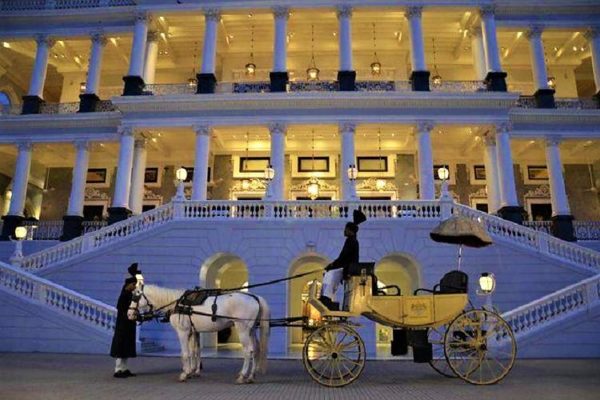The setting is perfect for breaking the fast in the holy month of Ramadan. A regal palace located on a hill, overlooking the old city of Hyderabad yet far from its chaos. The atmosphere serene, the ambience mystic, qawwali in the background — and to top it all, sumptuous Nizami food.
In this historic city, known for its rich Muslim culture and legacy, Taj Falaknuma is trying to recreate the royal Nizami Iftar experience at the palace which was once the residence of the Nizam, the ruler of erstwhile Hyderabad State and the richest man in the world of his times.
Ramadan is the time to be in this historic city, a fine blend of tradition and modernity. The city comes alive with the month-long festivities, enriched by an amazing spiritual ambience, fasts, feasts and shopping.
Taj Falaknuma is offering its guests a unique package of the lip-smacking royal dishes of the Nizam’s era, including some lost recipes.
At Falaknuma, which hosted guests like King George V of Britain and (the future) Czar Nicholas II of Russia during his India trip in 1890-91 when Czarevich (crown prince), guests get an opportunity to relive the life of royalty.
One can feast on to an array of Hyderabadi delicacies at Adaa, which has been ranked among top 100 restaurants in the world for the third consecutive year. Currently ranked 85, it is the only Indian restaurant in the world’s top 100 by Elite Traveller.
“We have tried to recreate the whole Nizami tradition of Iftar,” Ritesh Sharma, General Manager, Taj Falaknuma Palace, told IANS.
For breaking the fast, there is an exotic range of dates, fruits, nuts and other dry fruits with refreshing sherbats, dry fruit milkshakes and faloodas.
This is followed by dinner, in which the menu includes haleem, a popular dish in Hyderabad during the holy month. Taj is offering trio of haleem with chicken, lamb and seafood.
The delicacies from the Nizam era include “Murgh zameendoz” – marinated chicken wrapped in roomali roti and baked in a spit fire; “Nizami Gosht aur aaamras ke kofte” – mutton meatballs with mangoes cooked in a flavourful cashewnut grav; “Kebab-e-daryaee” – tender chunks of lamb, cooked on ‘dum’ along with onions and quail eggs; “Gilafi jheenga”, fried masala jumbo prawns, wrapped with puff dough; and “Murgh tajdar” – tender chicken breast flavoured with fennel seeds, star anise and cooked in a tandoor.
Then there is “Soofiyani safed biryani” – spring chicken marinated with cashew paste and curd, layered with rice and cooked on dum, topped with a fried quail; or “Hyderabadi dum gosht biryani” – tender lamb pieces marinated overnight, fragrant basmati rice, cooked in a sealed pot.
The desserts include Mango phirnee, Jauzi halwa, Rabdi aur elaichi ice cream, Baklava and stuffed dates.
Vegetarians will also have a full course with special dishes from the Nizam era, including a trio of Haleem with mixed vegetables, mushrooms and ‘kathal’ (jack fruit).
“We have taken utmost care to maintain the authenticity of the traditional dishes. A few are our own interpretations, keeping the modern techniques of cooking in mind,” said Executive Chef Sajesh Nair, who worked with a few prominent families in Hyderabad to revive some of the lost recipes, which require extensive and unique cooking techniques.
For resident guests, ‘Iftar’ excluding dinner comes free whether they are fasting or not, but for non-resident guests, it will be available when they book the dinner. At Adaa, the dinner per person costs Rs 5,500 plus taxes. At Gol Bungalow, the terrace, it costs Rs 7,500 plus taxes.
Your trip to Taj Falaknuma is incomplete without a walk through the palace and the hotel has ensured that you don’t miss out on this count while tasting the Nizami delicacies.
It was a decade ago that the palace was converted into a hotel by Taj Group after 10 years of painstaking work at a cost of $50 million to breathe life into the scorpion-shaped, all-marble palace, with all its opulent interiors and breathtaking views.
A majestic blend of Italian and Tudor architecture, it has 60 lavish rooms and halls decorated with ornate furniture, rich handcrafted tapestries and brocade from France.
It was Nawab Vaqar-ul-Umra, the Nizam’s Prime Minister, who built the palace in 1893. “After visiting many palaces in Europe, he built this palace to replicate heaven in Hyderabad and named it Falaknuma or reflection of the sky,” said historian Prabhakar Mahindrakar.
Impressed by its magnificence, Mir Mahboob Ali Khan, the sixth Nizam, bought it for himself and stayed in the palace till his death in 1911. Since then and till 1951, it was used as a royal guest house.






Leave a reply